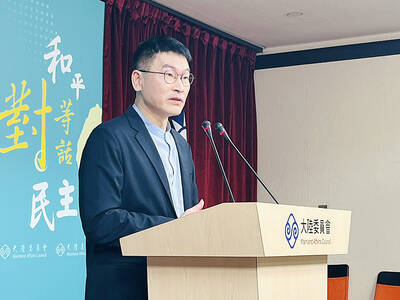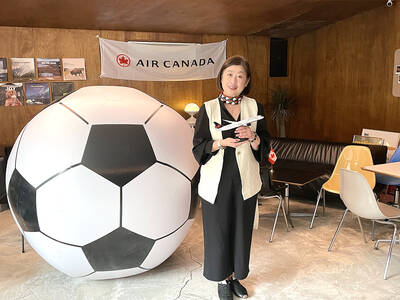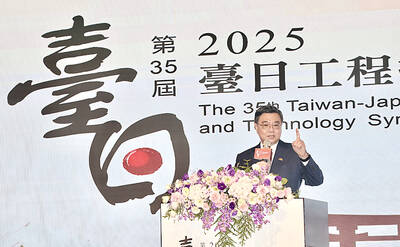Most electromagnetic waves people encounter in their daily lives are benign to humans, a group of international experts said yesterday at a conference in Taipei. The groups said that those concerned with radiation should avoid prolonged contact with electronic devices to reduce electromagnetic exposure.
As more and more home appliances and electronic devices — including wireless Internet, cell phones, computers and even hair dryers — permeate people’s daily lives, the Environmental Protection Administration (EPA) yesterday hosted a conference to discuss the impacts of non-ionizing radiation to human health.
EPA Department of Supervision, Evaluation and Dispute Resolution Director-General Yang Ching-shi (楊慶熙) said: “While many appliances emit electromagnetic waves, the radiation levels are so far below the international safety standard of 833 milligauss [mG] that people should not be overly concerned with their affects on health.”
“For example, washers and refrigerators emit a very low level of electromagnetic wave [20mG to 30mG], but most people would not put their heads close to these appliances for a long time,” he said.
Though hairdryers can emit radiation up to 300mG during use, Yang said that most people’s limited contact with the dryers would cause no adverse health effects.
In addition to the duration of exposure, Yang said that because distance to the radiation source drastically affected its exposure level, rearranging home furnishings could reduce one’s exposure to the waves.
“For example, though stereo systems may emit up to 35mG of radiation, it would pose little threat to people if they were far enough from the system,” he said.
Based on this practice — which the EPA nicknames “electromagnetic wave feng-shui” — Yang said that as a rule of thumb people should place their beds and sofas away from radiation sources.
Electromagnetic feng-shui techniques may come in handy for people who are concerned about non-ionizing radiation in their lives.
“While some people are allergic to electromagnetic waves and therefore may be more sensitive, others may feel that they are affected more because of psychological reasons,” Yang said.

LOW RISK: Most nations do not extradite people accused of political crimes, and the UN says extradition can only happen if the act is a crime in both countries, an official said China yesterday issued wanted notices for two Taiwanese influencers, accusing them of committing “separatist acts” by criticizing Beijing, amid broadening concerns over China’s state-directed transnational repression. The Quanzhou Public Security Bureau in a notice posted online said police are offering a reward of up to 25,000 yuan (US$3,523) for information that could contribute to the investigation or apprehension of pro-Taiwanese independence YouTuber Wen Tzu-yu (溫子渝),who is known as Pa Chiung (八炯) online, and rapper Chen Po-yuan (陳柏源). Wen and Chen are suspected of spreading content that supported secession from China, slandered Chinese policies that benefit Taiwanese and discrimination against Chinese spouses of

PROMOTION: Travelers who want a free stopover must book their flights with designated travel agents, such as Lion Travel, Holiday Tours, Cola Tour and Life Tours Air Canada yesterday said it is offering Taiwanese travelers who are headed to North America free stopovers if they transit though airports in Japan and South Korea. The promotion was launched in response to a potential rise in demand for flights to North America in June and July next year, when the US, Canada and Mexico are scheduled to jointly host the FIFA World Cup, Air Canada said. Air Canada offers services to 13 of the 16 host cities of the tournament’s soccer games, including Toronto and Vancouver; Mexico City, Guadalajara and Monterrey in Mexico; Atlanta, Georgia; Boston; Dallas; Houston;

The US approved the possible sale to Taiwan of fighter jet spare and repair parts for US$330 million, the Pentagon said late yesterday, marking the first such potential transaction since US President Donald Trump took office in January. "The proposed sale will improve the recipient's capability to meet current and future threats by maintaining the operational readiness of the recipient's fleet of F-16, C-130," and other aircraft, the Pentagon said in a statement. Trump previously said that Chinese President Xi Jinping (習近平) has told him he would not invade Taiwan while the Republican leader is in office. The announcement of the possible arms

ALIGNED THINKING: Taiwan and Japan have a mutual interest in trade, culture and engineering, and can work together for stability, Cho Jung-tai said Taiwan and Japan are two like-minded countries willing to work together to form a “safety barrier” in the Indo-Pacific region, Premier Cho Jung-tai (卓榮泰) yesterday said at the opening ceremony of the 35th Taiwan-Japan Modern Engineering and Technology Symposium in Taipei. Taiwan and Japan are close geographically and closer emotionally, he added. Citing the overflowing of a barrier lake in the Mataian River (馬太鞍溪) in September, Cho said the submersible water level sensors given by Japan during the disaster helped Taiwan monitor the lake’s water levels more accurately. Japan also provided a lot of vaccines early in the outbreak of the COVID-19 pandemic,